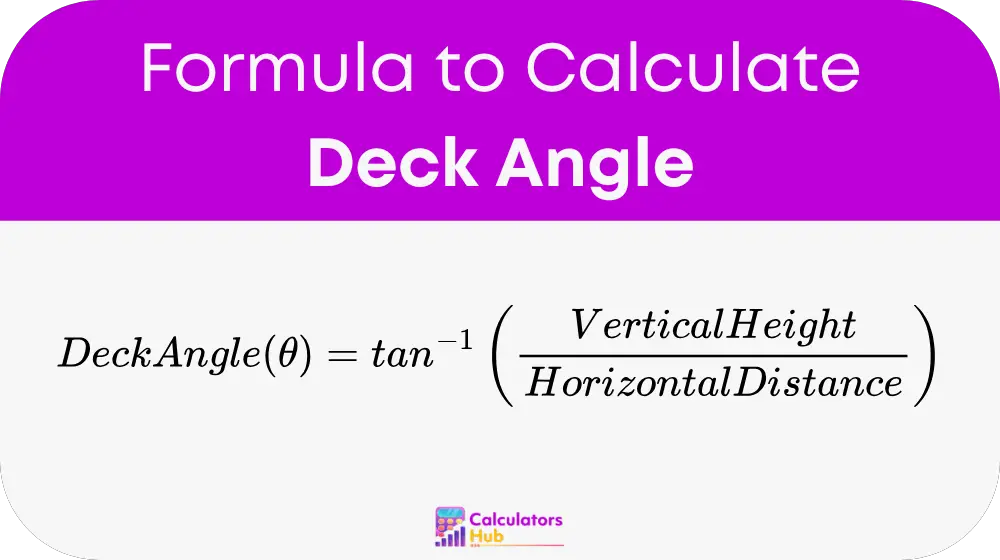A Deck Angle Calculator helps engineers, architects, shipbuilders, and aviation professionals determine the inclination of a deck relative to a horizontal reference point. This calculation is essential for maritime de stabilité analysis, aircraft takeoff and landing angles, and de construction unique en construction.
The deck angle provides insight into how much a surface is tilted from a level position, which is crucial in ship navigation, aircraft performance assessments, and safe deck construction. By calculating the deck angle, professionals can ensure that a structure or platform is within a safe and functional range of inclination.
Formula for Deck Angle Calculator
Le Deck Angle (θ) is determined using the inverse tangente (arctan) une fonction comme suit:

Où :
θ = Deck angle (in degrees)
Hauteur verticale = Height of the deck above the reference point (m or ft)
Distance horizontale = Distance from the base to the reference point (m or ft)
tan⁻¹ = Inverse tangent function (arctan)
Cette formule calcule le angle d'inclinaison en comparant les rise (vertical height) to the run (horizontal distance)L’ greater the vertical height relative to the horizontal distance, the steeper the deck angle.
Deck Angle Reference Table
The following table provides estimated deck angles for various height-to-distance ratios, offering a quick reference for professionals working with inclined surfaces.
| Vertical Height (m) | Distance horizontale (m) | Deck Angle (θ) | Application |
|---|---|---|---|
| 1 | 10 | 5.71 ° | Mild slope (walkways, gentle inclines) |
| 2 | 10 | 11.31 ° | Standard ship deck tilt in calm waters |
| 3 | 10 | 16.70 ° | Moderate aircraft climb angle |
| 4 | 10 | 21.80 ° | Steep ship inclination in rough waters |
| 5 | 10 | 26.57 ° | Critical tilt for heavy construction platforms |
| 10 | 10 | 45.00 ° | Extreme incline, typically avoided |
This table helps ship designers, pilots, and construction engineers estimate safe deck inclinations sans nécessiter de calculs manuels.
Example of Deck Angle Calculator
A ship's deck is tilted due to rough sea conditions. The élévation verticale is 2.5 mètresainsi que, horizontal base distance is 12 mètres.
Step 1: Apply the Deck Angle Formula
θ = tan⁻¹ (2.5 / 12)
Step 2: Compute the Ratio
θ = tan⁻¹ (0.2083)
Step 3: Compute the Angle
θ ≈ 11.79 °
Cela signifie que le ship's deck is tilte at an angle of approximately 11.79°, which is within a safe range for normal operations.
FAQ les plus courantes
The deck angle affects passenger safety, cargo stability, and navigational efficiency. A high deck angle in rough waters can lead to difficulty in movement, structural stress, and tipping hazards.
Aircraft need an optimal deck angle (climb angle) pour atteindre ascenseur efficace while maintaining safe aerodynamic performance. A angle raide can cause excessive drag, while a faible angle may not generate enough lift.
Yes, deck angle calculations help engineers design safe ramps, bridges, and building platforms, assurer que structural inclines comply with safety regulations et sont comfortable for human use.